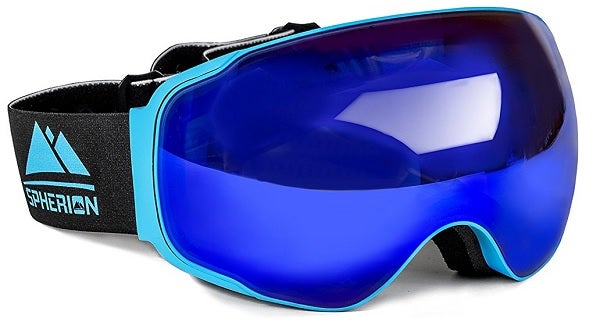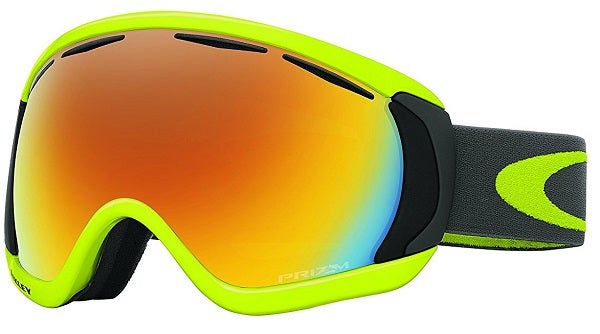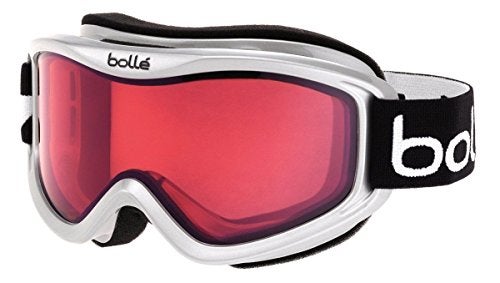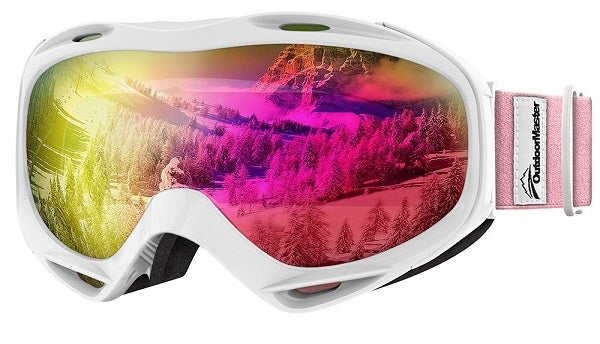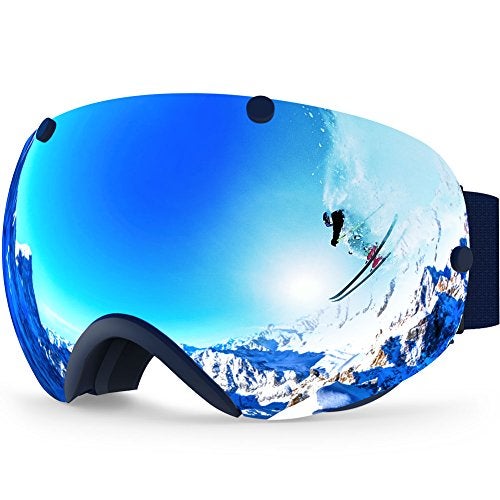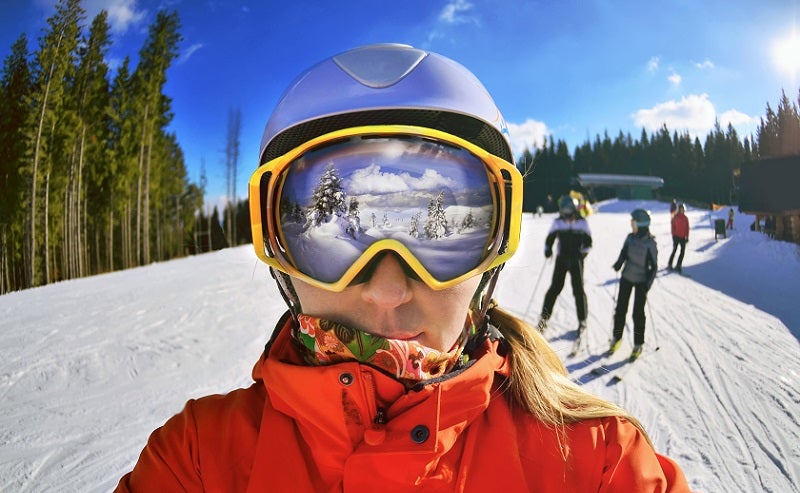
Our Editors independently research, test, and rate what we feel are the best products. We use affiliate links and may receive a small commission on purchases.
In this side-by-side product review Outside Pursuits leads you through everything you need to know in order to pick the best snowboard goggles for your specific needs and type of snowboarding.
We’ll take a look at what makes the best snowboard goggles for the money and what to avoid. Also see How To Choose The Best Snowboard Goggles later in the article. What are the best snowboarding goggles?
Best Snowboarding Goggles
Also see: Snowboard Googles Comparison Table and Snowboard Goggles Video Review
Quick Answer: The Best-Rated Snowboarding Goggles – [2021 Reviews]
- Spherion Gear Snowboard Goggles
- Oakley Men’s Canopy Snow Goggles
- Bolle Mojo Snowboard Goggles
- Smith Optics I/O Goggles
- Spy Optic Ace Bronze Goggles
- OutdoorMaster OTG Snowboard Goggles
- ZIONOR Lagopus XA Snowboard Goggles
Snowboard Goggles Reviews
#1 Spherion Gear Snowboard Goggles
Spherion isn’t necessarily a big name in snowboarding goggles, but users rave about this newcomer. The name of the game with Spherion is affordability and high-end features.
If you’re wanting a large profile goggle with a low price tag, this might be the one for you!
With up to 6 different styles to choose from, there’s something that will fit your style right out of the box. Some of these interchangeable lenses come with two lenses to start.
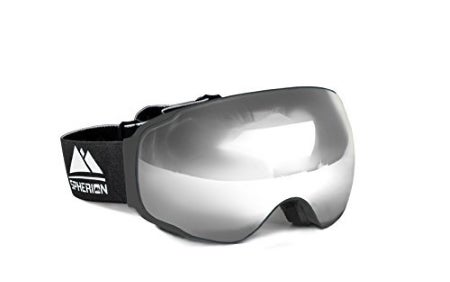
In these cases, you’ll get a dark reflective lens with tons of shading and sun protection, not to mention cool factor. You’ll also get a yellow low-light lens perfect for dark cloudy days where lighting is flat and low.
I like that they managed to nail most of the high-end features such as three-layer foam, all in an affordable package.
There’s a 22” inch adjustable strap with pivoting outriggers. These are ideal for adapting to various helmet sizes and positions.
Best For: Budget-minded snowboarders looking for high-end features.
#2 Oakley Canopy Snowboard Goggles
Oakley is an entrenched brand in the world of snowboard goggles. They have been making goggles for years and have perfected nearly every aspect of the process.
I love that these goggles come in a nearly unlimited variety of frame and lens colors. Want a black frame with pink lenses? Got it. Want white frames with blue reflective lenses? Got that, too.
I trust Oakley to make great lenses that combat high altitude UV light. Spending days at an altitude where UV light bounces off the snow and assaults your eyes can be dangerous and fatiguing.
That’s why you need the High Definition Optics 100% UV protection. Love it!
These lenses also excel in lens ventilation and face ventilation. This keeps your face cool without freezing your eyeballs, thanks to the row of foam vents near the top of the lens.
It also helps to keep sweat from condensing on the lenses which makes for a terrible time! These are even compatible with glasses (OTG) and make a great choice for any snowboarder!
#3 Bolle Mojo Snow Goggles
Bolle has been making this same style of goggle for… ever? It’s an extremely simple design with an insanely low price tag.
While you might pay several hundred dollars for top-line interchange goggles from a major brand, Bolle is just hanging out with these goggles around the $20 mark.
So how can they be that affordable? Well, ditch the spherical lens, drop the full UV protection, use a single layer of foam padding, simplify the goggle strap design, and keep the lenses as simple as possible. That’s what we’ve got here.
Does that mean you have to be a bad snowboarder to wear these goggles? No way. I’ve seen some of the best skiers and snowboarders I know wearing old school goggles that just work.
When you’ve got insane skill, there’s no need to show off with fancy gogs.
Best For: People who prioritize budget over all else!
#4 Smith Optics I/O Goggles
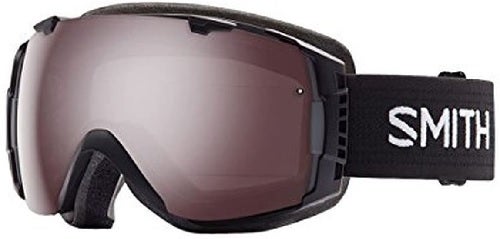 Ah, and so we come to it at last. The Smith I/O Goggles are, in my opinion, are the best snowboarding googles available to the modern shredder.
Ah, and so we come to it at last. The Smith I/O Goggles are, in my opinion, are the best snowboarding googles available to the modern shredder.
If you’re ready to take your game to the top, then you need to be rolling with the I/O goggles!
Why? Because the newest lens technology known as photochromic optics is incorporated into their design. Smith has trademarked their own format for this lens technology calling it ChromaPop.
Additional contrast and color delineation is the basic claim of this technology. On the slopes, it translates into better depth perception and contour recognition. Translation: you can see the bumps ahead more clearly and effectively.
Smith I/O goggles are a flagship product and would rank higher in our review but for their price. They come in tons of frame colors, and handfuls of lens colors and options. But that’s not enough to make them the best. They also feature a two-pane lens with one way breathability.
Remember that problem of water getting in between the lens layers? Not an issue with the I/O goggles.
The interchangeable lenses are quick to swap and each goggle comes with two lenses right out of the box. One dark and one light lens for each goggle.
There’s a 5x anti-fog coating and I’ve personally used these goggles for over 400 days on the mountain. They just don’t fog up! These goggles also come with a bonus microfiber goggle bag with replacement lens sleeve for your convenience.
They’ll fit over your glasses, and the wide-angle lenses have room to spare. The view is clear, crisp, and uncompromising.
Best For: Serious snowboarders who spend tons of time on the mountain.
#5 Spy Optic Ace
Much more similar to the Bolle Mojo goggles than the Smith I/O these goggles trend near the affordable and simple end of the spectrum. They do sport a few enhanced features though which we’ll dig into here!
Spy won’t leave you hanging, they’ve put in triple-layer foam for best in class comfort and dryness. While the lenses aren’t interchange, you could just buy several goggles at the low price of this goggle.
I do like that they’ve engineered the goggles for 100% UV protection. They also put in a dual-pane lens to reduce or eliminate fogging issues.
I would be careful if you’re rocking a large helmet though, as the straps may not adjust large enough for some.
What you lose at this price are spherical lenses, advanced ventilation, large adjustable straps, interchangeable lenses, and other top-end features of hardcore goggles.
Best For: Beginners or those seeking to keep the price down!
#6 OutdoorMaster OTG Snowboard Goggles
These goggles from OutdoorMaster heavily rely on an old Oakley design. They’re available with nice looking reflective lenses in a variety of colors to the tune of 10+ different variations.
They come with a carrying pouch and a 6-month warranty. OTG goggles are made to fit over the top of your glasses so those with eyewear will have space to comfortably wear glasses inside these goggles.
They do have a dual-layer lens and advertised 100% UV protection. Because I don’t know OutdoorMaster as a brand, it’s hard to say if they live up to that.
I would worry a bit about the size of the helmet strap and the overall quality. I would consider these goggles for budget-minded snowboarders, or those just getting started.
The lenses are quite narrow and field of view is one of the biggest factors in google quality, so I have to ding them for that factor.
Choose these goggles if you’re just getting started and want a high-end looking goggle at a low price!
#7 ZIONOR Lagopus XA Snowboard Goggles
Possibly the most outlandishly large lenses I’ve seen on a goggle, the Zionor lenses look like they belong in a jet fighter cockpit. That said, large lenses mean great field of view, and that’s one of the ultimate factors in goggle quality overall!
I love the dual-lens and top-end foam use. This means a dry and comfortable experience with minimal fogging or condensation.
Dual-layer anti-fog and glare coatings on the lens help to keep the image quality as sharp as possible in all conditions.
It is a spherical lens construction, but the flexible lens may bend a bit too much to keep the view perfect.
With all the features of top-end goggles and a price that can compete with even the Bolle Mojo it leaves me wondering how they keep the price down.
Users rate these goggles as 4 of 5 stars currently but I would be hesitant to stake them as a competitor against Oakley or Smith just for quality and reliability questions.
Best For: Large unrestricted field of view at a budget price for any snowboarder.
Snowboarding Goggles Comparison Table
| Best Snowboarding Goggles | Lens Type | Lenses Included | Special Features | Customer Ratings | |
|---|---|---|---|---|---|
| Spherion Gear Snowboard GogglesHello test | Oversized Double Poly-Carbonate Spherical Lens | (1) Daytime and (1) Low-Light Amber | Triple Layer High Density Oleophobic Foam Padding Both Protects and Safely Seals Protecting From Wind and Cold | 3.7 / 5.0 | |
| Oakley Men’s Canopy Snow Goggles | Plutonite lenses with F3 anti-fog coating for superior fog elimination | Choice of (9) styles with (1) dark, reflective lens installed | High Definition Optics (HDO), and 100% protection against UVA, UVB, UVC and harmful blue light | 4.6 / 5.0 | |
| Bolle Mojo Snowboard Goggles | Carbo Glass with Bolle's P-80+ premium anti-fog layer | Non-reflective lens with UV protection installed | P80 Plus/Carbo GLAS (anti-fog/anti-scratch) coating provides protection against unwanted lens fogging | 4.4 / 5.0 |
|
| Smith Optics I/O Goggles | Select colorways available with ChromaPop, Spherical Carbonic-X Lens with TLT Optics and 5X Anti-Fog inner Lens | 2 lenses, one dark and one light, Choice of 24 styles | Responsive Fit Frame design, Ultra-Wide, Silicone Backed Strap, and Dual-axis outrigger positioning system, and goggle bag | 4.5 / 5.0 |
|
| Spy Optic Ace | Anti-fog, anti-scratch injected SIC (Superior Injected Curve) | Triple layer Isotron face foam with moisture-wicking Dri-Force fleece | Patented Scoop ventilation system , 100% UV protection | 4.4 / 5.0 |
|
| OutdoorMaster OTG Snowboard Goggles | Dual-layer lens technology with anti-fog coated inner lens | Soft TPU frame with lenses that provide 100% UV400 protection | Extra long elastic strap ensures great helmet compatibility with all helmets | 4.3 / 5.0 |
|
| Zionor XA Ski Snowboard Snow Goggles | Anti-fog and two way venting for clear and clean vision | PC lens + TPU frame for impact-resistance | Anti-winds and keep you warm, 100% UV400 Protection | 4.3 / 5.0 |
Author’s Expertise / Why You Should Trust Our Reviews
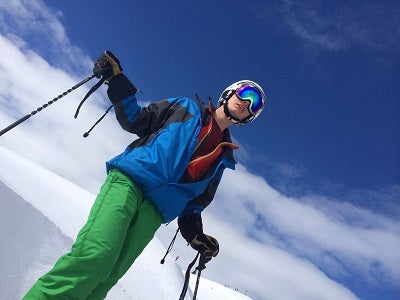
I started writing online for my own outdoor sports blog in 2010. Right out of the gate I landed opportunities to test gear for Road ID, Hydrapak, Wolverine, Helle Knives, Pearl Izumi, and GU Energy. Those were the days when growing a no-name blog was easy. Today niche blogging is a different story.
In 2012 I left Central Wyoming College with a degree in Outdoor Education and Leadership. Soon after, I was on a month-long expedition with the National Outdoor Leadership School’s Outdoor Educator Course which helps would-be outdoor guides ascend from “aspiring” to “inspiring”.
Between here and there I’ve participated in and spoken at length about outdoor pro-deal programs for companies like Patagonia, Smith Optics, Giro, Therm-a-Rest, Platypus, MSR, Columbia, and many more. I still work closely with tons of outdoor gear companies to review and analyze products. If you have a product opportunity you’d like to discuss, please review my guidelines and contact me here.
After several seasons of guiding backpacking trips and working as a certified Alpine Ski Instructor at Deer Valley Resort in Park City, UT for several seasons, I had to move on. As any educator will tell you – teaching doesn’t pay the bills very well.
In 2016 I began building my freelance writing career as readers and other bloggers reached out to me for help with technical outdoor sports content strategy for online businesses. Within weeks I was overloaded with requests for freelance writing and my new career blossomed.
2018 saw the launch of Hike With Less, my ultralight backpacking partnership program with Dustin Walker.
How to Choose the Best Snowboarding Goggles for You
- Field of View
- Interchangeable Lenses
- Lens Padding
- Anti-Fog Coatings
- Spherical Lenses
- Goggle Straps
- Conclusion
- FAQs – Frequently Asked Questions
In the world of snowboarding, there’s no piece of gear more critical than your goggles. Snowboards are the biggest and flashiest piece of gear you’ll use on the mountain. Jackets and pants define your style.
But having the best snowboard goggles can make the difference between seeing what’s in front of you, and burying the tip of your snowboard in a mogul and tomahawking into the snow.
I’ve taken a few nasty diggers in poor lighting conditions, even with great goggles. They can’t save you from everything, but it sure helps to see what’s coming.
Today’s goggles offer large views, clearer field of vision, greater clarity and depth, as well as protection from the elements.
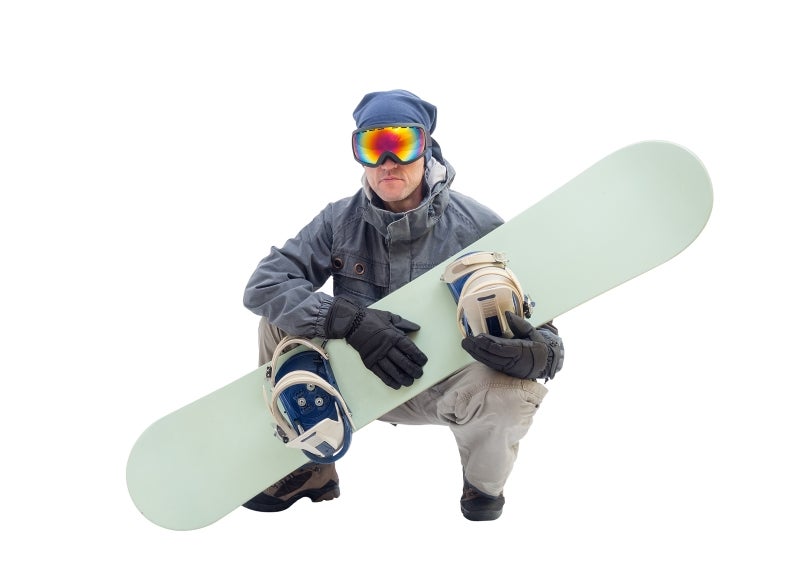
Understanding how to choose the best snowboarding goggles for you isn’t as easy as it may seem. With over 500 days on the mountain over the last 5 years, I’m going to help lend my experience to your decision-making process.
Field of View
Most goggles today are trending toward large, bug-eye looking things. In the past goggles were slim, fit near the face, and usually had smaller lenses. Today’s goggles have morphed into wide-view monsters that really up the game.
The larger profile and wraparound style lenses on today’s goggles aren’t just for looks. A great goggle needs to maximize your peripheral view so you can scan for incoming snowboarders, trees, bumps, and terrain features.
If you’re still wearing narrow, tight-fitting goggles you need to ditch them! Being able to see what’s around you will improve your snowboarding and reduce the chances of injury from previously unseen hazards.
Interchangeable Lenses
Seems like a gimmick for goggle makers to get more money out of you, doesn’t it? Well, not only does it help with style points, interchange lenses also help snowboarders adapt to changing light conditions.
From day to day, or hour to hour, light conditions on the mountain can change rapidly! With a clear lens, for instance, a bright sunny day can damage your eyes.
However, with a dark lens, a cloudy stormy day becomes dangerous as visibility is reduced to near zero.
By changing lenses on the fly you can adapt safely to light conditions. I always keep a dark lens and a light lens on me at all times. I’ve had to ski down in blizzard conditions with a dark lens before… it’s not fun! Don’t get caught with your lenses down!
Lens Padding
Another seemingly trivia factor that just simply isn’t. Lens padding makes the difference between a comfortable fit and wear versus sweaty, scratchy days on the mountain.
Cheap goggles use a single layer of open-cell foam to pad the face. This sucks and breaks down quickly!
Today’s goggles use a three-layer foam system that greatly improves on past designs. Open-cell foam is usually just the beginning.
From there a second layer of softer cushioning foam is added. It’s all topped off with a layer of microfiber that absorbs sweat and sits nicely against the skin.
If your old goggle foam is crumbling and failing, it’s time to upgrade!
Anti-Fog Coatings
Fog and condensation on lenses is a real pain in the ass. When things are already dark and stormy outside, the last thing you want is a foggy lens when the temps drop and the clouds roll in.
At one time it was common to apply aftermarket products, or just spit on the lenses and smear it around to prevent fog. No more!
Good lenses today come with anti-fog coatings pre-applied. Like any great optical system, anti-fog lenses improve the reliability of each ride.
If you do begin to get condensation or fogging that just won’t go away, your lenses may need replacing. On newer 2-layer lenses sometimes moisture can get in between the lens layers and create problems. Replace lenses if this happens.
Spherical Lenses
Today’s top lenses are perfectly spherical in shape. They’re made to be perfectly in line with your eye’s view of the world and thereby avoid distorting dimensions or shapes of things around you.
This is achieved by creating a lens that is a portion of a perfect sphere. Most top lenses today are spherical. It’s not a sales gimmick – it really does provide the absolute best in image quality.
Goggle Straps
A quick word about goggle straps! There are a few things to keep in mind with goggle straps and, in the spirit of helping you out, I’m going to share them here.
Almost all goggle straps today are coated with a silicone bead. This sticky silicone layer helps the goggle strap stay in place on the helmet. It’s a small feature that makes a big difference!
The other thing to keep in mind when buying goggles is strap size. I wear an XL helmet and some goggle straps struggle to fit fully around the helmet.
This leaves the goggles uncomfortable tight on my face, pinching my nose. Avoid this by trying on goggles with your helmet before purchasing.
Conclusion
We hope this review and comparison of snowboarding goggles has been helpful to you. If you’re new to the sport and want to get started with some basic instructions, see our helpful guide entitled: How to Snowboard – A Beginner’s Guide.
Ultimately, when selecting goggles for snowboarding, it’s up to you to decide what makes sense for your needs.
Upgrading to goggles with spherical lenses, anti-fog features, and wide field of view was one of the best things I ever to improve my time on the mountain.
I would suggest highly that you spend top dollar on your goggles if you want to move your snowboarding game to the max.
Of course, we all have different priorities and you’ll find goggles from the top to near the bottom of the price range on our list.
Snowboard Goggles FAQs – Frequently Asked Questions
Question: Which is more fog-proof: dual-pane lens or anti-fog spray?
Answer: I always opt for a dual pane lens on any goggles. In my view, there’s just no reason to own a single pan lens on mountain goggles for any sport where vision is critical.
Fogging is a real issue and it will happen. Even with dual pane lenses, things like balaclavas or neck warmers can still redirect hot breath onto lenses and cause fogging.
To have the best shot at seeing what’s in front of you (and staying safe) and dual pane lens provides the most reliable anti-fog option by far.
As a note, it’s almost never okay to use anti-fog spray on a modern dual pane lens. Because the inner lens layer is usually made from softer, more sensitive material the fog spray, saliva, or rubbing a micro-fiber cloth can all cause permanent damage to those soft lenses.
Question: Should I drop big bucks on a name brand or go with something cheaper?
Answer: This one is totally up to you.
I’ve seen people totally happy with inexpensive $30 goggles that look and perform just as good as high end models. Personally, I’ve always had pro deals to make expensive goggles more affordable so I had a bit of a luxury. I will say those name brand (Oakley, Smith, etc.) goggles are invariably quite nice!
I will also say that some “off brand” goggles have caught my attention on the hill before. Sometimes I catch myself thinking, “dang, those look good!” So, in the end I guess it’s probably a bit of a wash…
Question: The foam on my goggle frame is falling apart, can I repair it?
Answer: The answer to this is almost always a resounding “no”.
Trying to replace goggle foam never works well. It either shreds, doesn’t hold up, falls off, or otherwise fails pretty quickly. Plus, the foam used on modern goggles is complex 3-layer foam with soft micro-fiber coatings to make it feel good against the skin.
Older goggles have a single layer of open cell foam and this foam is always in a state of disrepair. Don’t even bother trying to save it – just upgrade to a modern goggle. You’ll be happy you did, trust me.
Question: Are big goggles just a fashion statement, or are they helpful?
Answer: They’re a little of both.
Today’s goggles have kind of made their name by going bigger and bolder. That’s the name of the game right now.
It’s not all for show, though.
Those reflective lenses look good, but also help keep harmful rays from hitting your eyes. The huge lenses and frames sit on the face more gently. Plus, those big lenses provide better peripheral vision.
If you’ve ever had someone come flying by and nearly knock you off your snowboard yelling, “On your left!” you’ll know that peripheral vision is important to staying safe on the mountain. The more you can see, the safer you’ll be!
Thanks for reading The 7 Best Snowboard Goggles Reviewed. We hope this article has helped you to discover the best choice for snowboard goggles to meet your needs and type of boarding. You might also be interested in our informative article entitled, How to Snowboard – A Beginners Guide.
If you have any questions or comments for us just use this Contact Form.
For more of our top snowboarding gear recommendations, have a look through these popular Outside Pursuits review articles: Snowboarding Boots, Snowboard Bindings, Snowboard Goggles.
Have fun and enjoy your time on the slopes!
MORE WINTER GEAR SNOWBOARD HELMETS | SNOWBOARD GOGGLES | PARK & FREESTYLE SNOWBOARDS | WOMEN’S SNOWBOARDS | ICE SKATES | SNOW SLEDS | ICE HOCKEY SKATES | ICE AUGERS | WINTER SLEEPING BAGS | HEATED GLOVES | BASE LAYERS | ICE FISHING BOOTS
Snowboard Goggles Video Review
How We Researched
To come up with the best snowboard goggles, we researched a variety of sources for reviews such as REI, Backcountry, Moosejaw, EVO along with our own personal experience.
We also consulted online magazines for product research and reviews to get as much unbiased information as we could. To help weed out fake reviews we used Fakespot.com to make sure we only looked at genuine reviews.
With so much quality gear available, we had to narrow it down based on what we felt were the best options were for the price. The author, Casey Fiedler was a full-time ski instructor for Park City and The Canyons in Utah.
To help narrow down the selection he used his personal experience along with recommendations from fellow ski instructors.
After extensive research, we came up with our list to help you choose the right one for you.
Sources



